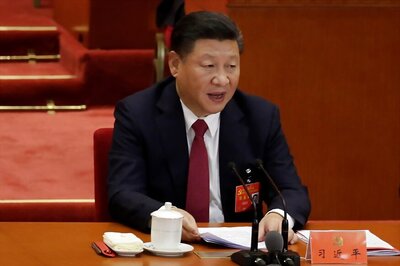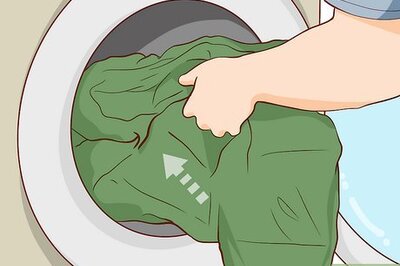
views
The spotlight in any discussion on the end of the British Raj in India is overwhelmingly focused on the last viceroy, Louis Mountbatten. That, however, is an injustice to his predecessor Archibald Wavell, for while Mountbatten hurried through the process in an unimaginable rush, it was Wavell who almost accurately foresaw how the situation in India was going to shape up at the end of World War II. Wavell’s prognosis is especially creditable because he painted the post-war scenario in India with a large degree of accuracy and catalysed the transfer of power. The only deficiency in his projection was the absence of one factor which no one at that time could have foreseen.
It was in October 1943 that Wavell succeeded the Marquess of Linlithgow as India’s viceroy. While the world war raged on, all prominent Congress leaders were in prison, the Quit India Movement had been ruthlessly suppressed and Subhas Chandra Bose had opened a new front from Southeast Asia with Japan’s help.
Wavell felt it was prudent to take a proactive approach towards the question of India’s independence at the end of the war rather than merely responding to events as they unfolded. On this approach, he received a large measure of support from the governors of the provinces and the commander-in-chief (C-in-C) of the British Indian Army. Strengthened by this support, Wavell articulated his thoughts about the end of the war situation in India in a letter to the Secretary of State for India and Burma Leo Amery on September 5, 1944. He was remarkably prescient in projecting an explosive scenario that was likely to emerge at the end of the war, primarily driven by ‘the demobilisation of the Indian Army, the dispersal of labour from war factories, and the winding up of large war establishments employing many thousands of clerks’ at a time when the Congress leaders could not be held in detention more.
The ideal way to deal with such a thorny situation, in Wavell’s view, was to channelise the disruptive energy of the agitating leaders to manage administrative problems. “If trouble is to be avoided we must find some outlet for the administrative and political energy of the Indian Parties, including the Congress and the Muslim League, and this can be done only by active steps to get the political problem solved,” he wrote to Amery. His suggestion was to form a transitional government at the Centre as soon as possible, representative of the main political parties, to carry on the administration of the country under the existing Constitution until a new one was framed. Wavell’s proposals, however, failed to enthuse Amery.
An unrelenting Wavell brought up the matter again with Churchill on completing a year as viceroy, gently yet unambiguously pointing out Churchill’s apathy towards India, knowing well that the British prime minister wouldn’t like his ideas. He highlighted the question of the British Commonwealth’s future influence in the larger region being dependent on its relationship with India. Among other things, he wrote: “I will begin by saying that my primary reason for writing is that I feel very strongly that the future of India is the problem on which the British Commonwealth and the British reputation will stand or fall in the post-war period. To my mind, our strategic security, our name in the world for statesmanship and fair dealing, and much of our economic well-being will depend on the settlement we make in India.
And yet I am bound to say that after a year’s experience in my present office, I feel that the vital problems of India are being treated by H.M.G. [His Majesty’s Government] with neglect, even sometimes with hostility and contempt.”
“If our aim is to retain India as a willing member of the British Commonwealth, we must make some imaginative and constructive move without delay,” Wavell argued. He had no doubt that “if we want India as a Dominion after the war, we must begin by treating her much more like a Dominion now.”
Explaining the factors that were likely to turn into a ‘fertile field for agitation,’ Wavell warned Churchill that “We cannot move without taking serious risks; but the most serious risk of all is that India after the war will become a running sore which will sap the strength of the British Empire. I think it is still possible to keep India within the Commonwealth, though I do not think it will be easy to do so. If we fail to make any effort now we may hold India down uneasily for some years, but in the end she will pass into chaos and probably into other hands.”
His proposals, however, found little support from the British government. When Wavell met Churchill at Downing Street on March 29, 1945, the prime minister told him bluntly that he had had no time to consider India and thought that the India issue “could be kept on ice”. Developments, however, soon gathered pace. The surrender by Germany on May 7 was followed by the resignation of the British Labour Party from the wartime coalition government on May 23. With the British general elections scheduled for July 1945, the caretaker government under Churchill finally agreed at the end of May to initiate the process for constitutional reforms in India. The plan included setting up a new viceroy’s executive council, entirely Indian, except for the viceroy himself and the commander-in-chief. The executive would work within the existing constitution, but the door would be kept open for discussion on a new constitution once the war was over.
The members of the Congress Working Committee were released from prison to participate in the Simla Conference held between 25 June and 14 July to discuss the formation of the new executive council with the viceroy and leaders of other political organisations. The conference failed to reach an agreement, but negotiations continued. Soon the focus shifted to the elections to the central and the provincial legislative assemblies, scheduled to be held at the end of 1945 and early 1946, respectively.
Wavell and the British government had every reason to be satisfied that the Indian political parties had been entangled in the process of constitutional reforms through negotiations and were expected to be busy in the formation of governments in the provinces. It appeared that Wavell’s plan was working. There was nothing in the political environment that could even remotely indicate the possibility of a mass movement. The politics of agitation for driving out the British had been fairly successfully redirected to the politics of forming executive councils and provincial governments.
No one in the British administration, however, had grasped to what extent India’s national politics was to be shaken up by another development that was taking in parallel. The very existence of the Azad Hind Fauj or the Indian National Army (INA), which had fought to liberate India under Bose in alliance with Japan, had been completely suppressed in the Indian press and was officially announced through a press statement only on May 10, 1945.
Public opinion started crystallising on the INA as the soldiers were brought back to India after Japan’s surrender on August 15, 1945. The Congress, which was organisationally weak with no concrete programme, was handed over a readymade issue to go into the polls when the government declared its intention to hold public trials of the INA soldiers. The issue, however, blew up into something much more than a poll issue, galvanising the entire country into agitation mode, and threatening to derail the process of negotiations.
The release of the INA soldiers became the rallying point of all political organisations. Meetings and processions were organised to observe Azad Hind Day throughout the country after the trials commenced. Between November 21 and 24, serious rioting broke out in Calcutta, followed by riots in Bombay, Karachi, Patna, Allahabad, Banaras, Rawalpindi and other places. Clashes between demonstrators and the police took place in Lucknow, Madurai and Lahore too. The political situation in India had quickly transformed into a volcanic one, with the constitutional path facing the risk of being totally discarded in favour of a mass upheaval. A fresh round of rioting took place in Bombay during Bose’s birth anniversary celebrations on January 23, 1946. The sentiments generated by the trial of the INA soldiers led to unprecedented mutinies, first in the Royal Indian Air Force (RIAF) followed by the Royal Indian Navy (RIN), from February 18, 1946. These, combined with the labour and student movements, across the country.
This was the nightmarish situation that Wavell had hoped and worked hard to avoid, but without success. The viceroy and the governors had been working furiously to bring an end to this situation with the help of Gandhi and their efforts had started showing results. Once the elections were over, the Congress had once again embraced peace and non-violence. Gandhi, Patel and Nehru exerted all their influence to put a brake on outbreaks such as the RIN revolt. Yet, it was clear that the Raj had lost the confidence of the Indian soldiers and that the country was ready for a mass upheaval.
It was under these circumstances that the Clement Attlee government decided in mid-January 1946 to send the Cabinet Mission to India that would set in motion the process of transferring power.
Chandrachur Ghose is author of the national bestsellers ‘1947-57, India: The Birth of a Republic’ (2023) and ‘Bose: The Untold Story of an Inconvenient Nationalist’ (2022), both published by Penguin. Views expressed in the above piece are personal and solely those of the author. They do not necessarily reflect News18’s views.


















Comments
0 comment